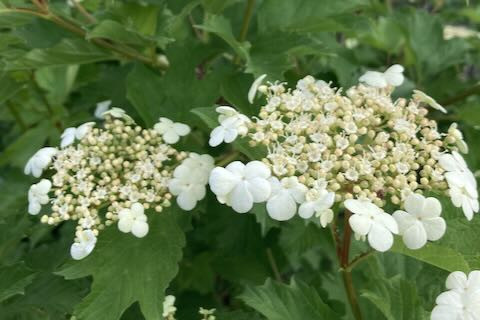
Rosmarinus officianalis 'Portugese Pink'
Portugese form of the pink rosemary, more true pink than Majorca pink and less upright, bushier and lower growing.


Medium deciduous shrub with clusters of white lacecap flowers in spring, followed by red berries during winter. Attractive specimen shrub with good autumn colour.
Medium deciduous shrub with clusters of white lacecap flowers in spring, followed by red berries during winter. Attractive specimen shrub with good autumn colour.
Data sheet
Portugese form of the pink rosemary, more true pink than Majorca pink and less upright, bushier and lower growing.
This is the best variety for drying and essential oil production, as it has a higher than usual oil concentrate in the leaves. Used in the production of cosmetics and fragrances.
Beautiful semi deciduous shrub with attractive textured multicoloured leaves and white flowers, likes good drainage and shade or dappled sun. Can often retain its leaves but benefits from an occasional light prune to promote basal growth.
One of the better Westringia erimicola cultivars that shapes very well, and provides a lasting dense hedge or screen. Lavender flowers and great bird habitat, avoid winter wet.
Old fashioned blue mop top hydrangea, needs acid soil to colour up well. Will go towards pink in alkaline soil.
Tasmanian native bottlebrush with pale yellow flowers in spring. Makes a good bushy hedge, particularly good on clay soils. Trim annually for best results from an early age.
Vigourous old fashioned mop top type, pure white flowers, useful for specimen or border plantings. Strong stemmed upright variety, useful for floral work.
A wonderful variety with large white flowers like Romneya coulteri, unfortunately difficult to propagate so only a few.
Traditional white mop top Hydrangea, flowers do not discolour with pH variation, plants form a good low hedge or border in shady conditions.
Attractive deciduous specimen shrub, new growth is pink and green which becomes transforms to burgundy and flame red as the season progresses into autumn. Drought and frost hardy, slow growing.
Semi prostrate medium blue form with cascading habit, useful winter flowering ground cover.
Deciduous 'snowball tree' with fluffy white snowball flowers . Lovely variety, good specimen shrub or small tree.
Attractive shrub with pepper flavoured berries and leaves . Also a superb container specimen for part shade. Large plants.
A dense growing multi stemmed variety prized for topiary and hedging, featured at Sissinghurst Castle. Bright blue flowers.
Glossy green hedging shrub with sweetly fragrant white flowers in winter. Best in cool conditions.
Our local banksia which is widespread across Tasmania. This is the upright form which makes a large shrub or small tree which is lovely as a specimen, or clips well as a hedge or screen. Also a good pot plant.

Medium deciduous shrub with clusters of white lacecap flowers in spring, followed by red berries during winter. Attractive specimen shrub with good autumn colour.